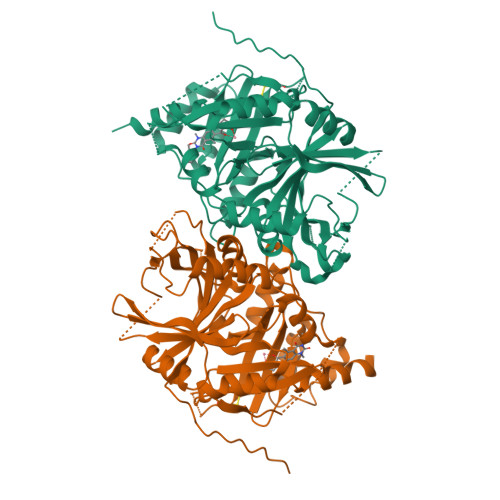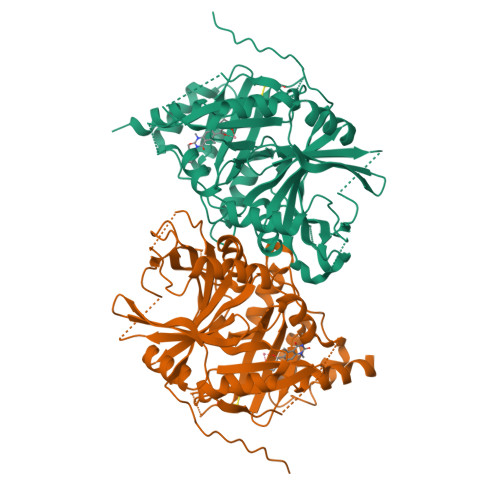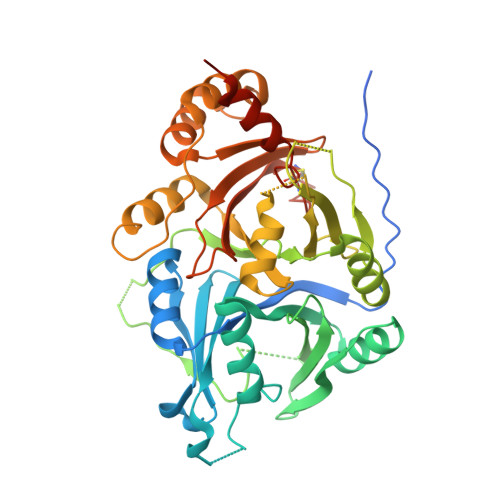Structure-Guided Discovery of Silicon-Containing Subnanomolar Inhibitor of Hydroxyphenylpyruvate Dioxygenase as a Potential Herbicide.
Qu, R.Y., Nan, J.X., Yan, Y.C., Chen, Q., Ndikuryayo, F., Wei, X.F., Yang, W.C., Lin, H.Y., Yang, G.F.(2021) J Agric Food Chem 69: 459-473
- PubMed: 33395281
- DOI: https://doi.org/10.1021/acs.jafc.0c03844
- Primary Citation of Related Structures:
5YWK, 6M6D - PubMed Abstract:
4-Hydroxyphenylpyruvate dioxygenase (HPPD, EC 1.13.11.27) has been recognized as one of the most promising targets in the field of herbicide innovation considering the severity of weed resistance currently. In a persistent effort to develop effective HPPD-inhibiting herbicides, a structure-guided strategy was carried out to perform the structural optimization for triketone-quinazoline-2,4-diones, a novel HPPD inhibitor scaffold first discovered in our lab. Herein, starting from the crystal structure of Arabidopsis thaliana ( At )HPPD complexed with 6-(2-hydroxy-6-oxocyclohex-1-ene-1-carbonyl)-1,5-dimethyl-3-( o -tolyl)quinazoline-2,4(1 H ,3 H )-dione ( MBQ ), three subseries of quinazoline-2,4-dione derivatives were designed and prepared by optimizing the hydrophobic interactions between the side chain of the core structure at the R 1 position and the hydrophobic pocket at the active site entrance of At HPPD. 6-(2-Hydroxy-6-oxocyclohex-1-ene-1-carbonyl)-1,5-dimethyl-3-(3-(trimethylsilyl)prop-2-yn-1-yl)quinazoline-2,4(1 H ,3 H )-dione ( 60 ) with the best inhibitory activity against At HPPD was identified to be the first subnanomolar-range At HPPD inhibitor ( K i = 0.86 nM), which significantly outperformed that of the lead compound MBQ ( K i = 8.2 nM). Further determination of the crystal structure of At HPPD in complex with compound 60 (1.85 Å) and the binding energy calculation provided a molecular basis for the understanding of its high efficiency. Additionally, the greenhouse assay indicated that 6-(2-hydroxy-6-oxocyclohex-1-ene-1-carbonyl)-1,5-dimethyl-3-propylquinazoline-2,4(1 H ,3 H )-dione ( 28 ) and compound 60 showed acceptable crop safety against peanut and good herbicidal activity with a broad spectrum. Moreover, compound 28 also showed superior selectivity for wheat at the dosage of 120 g ai/ha and favorable herbicidal efficacy toward the gramineous weeds at the dosage of as low as 30 g ai/ha. We believe that compounds 28 and 60 have promising prospects as new herbicide candidates for wheat and peanut fields.
Organizational Affiliation:
Key Laboratory of Pesticide & Chemical Biology of Ministry of Education, International Joint Research Center for Intelligent Biosensor Technology and Health, College of Chemistry, Central China Normal University, Wuhan 430079, P. R. China.


















